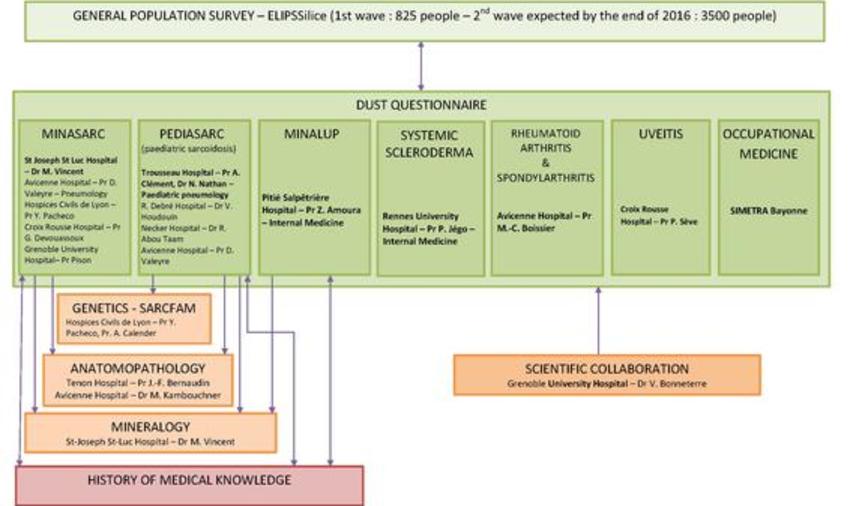The Silicosis Project

 The investigational device
The investigational device
Silicosis is an innovative new research project combining history, medicine and the social sciences. The project deals with one of the deadliest occupational diseases in history, silicosis, caused by the inhalation of crystalline silica dust particles.
Directed by Paul-André Rosental, the five-year project was launched in June 2012, funded by a European Research Council Advanced Grant and based at Sciences Po’s Center for European Studies, in association with the Center for History. ERC Advanced Grants allow exceptional, established research leaders to pursue ground-breaking, high-risk projects that open new directions in research.
In addition to Professor Rosental, the Silicosis team is composed of two sociologists, a pulmonologist, a mineralogist, a post-doctoral researcher in historical demography and a project officer. The medical aspect of the project is carried out in collaboration with the Minapath laboratory of the Centre Hospitalier St Joseph-St Luc in Lyon.
Here is an article of Le Journal du CNRS on the Silicosis Project
Silicosis: a ‘negotiated’ disease
One of the world’s oldest industrial diseases, silicosis was traditionally widespread in many industries (from construction to glasswork, stonecutting and sandblasting) – although mainly identified with mining in the public imagination. It decimated workers around the world in the 19th and 20th centuries. The disease remains present in industrialised countries, and is rampant in many countries with emerging economies.
The medical definition and diagnostic criteria of silicosis were far from being exclusively scientifically driven. They are the result of negotiations in the 1930s between employers, workers’ unions and States under the auspices of the International Labor Organization. These produced a truncated and deliberately minimal definition of the disease, designed to reduce compensation claims.
The consequences have reverberated down the decades and include a massive under-reporting of silicosis cases, many of which were misdiagnosed as tuberculosis – a non-occupational disease for which employers were not liable to pay compensation.
Importantly, these negotiations also resulted in silicosis “monopolizing” our understanding of the pathological effects of silica dust, which is now suspected of generating a range of systemic – and not necessarily pulmonary – diseases of unknown origin.
From ‘silicosis’ to ‘silica hazards’
Silicosis is revisiting this complex history, combining social science with scientific knowledge and technology from pulmonology and public health.
The project is re-examining the 20th century epidemiology of silicosis and tuberculosis from a transnational perspective and investigating whether official recognition of silicosis in the 1930s may have unintentionally impeded a broader understanding of silica hazards, and whether going back to the medical knowledge of that time may open new paths of contemporary research.
It will also check to what extent a series of other chronic inflammatory diseases (sarcoidosis, rheumatoid arthritis and others) is likely to be caused, at least in part, by exposure to silica dust.
Last but not least, Silicosis hopes to promote better prevention and awareness of the dangers of silica dust exposure beyond the mining sector, for instance in the construction industry and foundries.
The Silicosis project aims to establish whether certain chronic inflammatory diseases are caused, at least in part, by exposure to crystalline silica dust. To reach this goal, the team works with various medical teams : the Pneumology Department (Pr D. Valeyre) and the Rheumatology Department (Pr M.-C. Boissier) of the Avicenne Hospital, the Internal Medicine Department (Pr P. Jégo) of the Rennes University Hospital, the Internal Medicine Department (Pr Pascal Sève) of the Hospices Civils de Lyon, the Pediatric Pneumology Department (Pr A. Clément, Dr N. Nathan) of the Trousseau Hospital and the Internal Medicine Department (Pr Z. Amoura) of the Pitié - Salpêtrière Hospital. Each study combines the administration of a dust questionnaire to the selected patients (the results being then compared to those of the same questionnaire administrated to the general population), together with anatomopathology and mineralogy analyses.
Diagram of the investigational device (PDF, 84ko)
The Minasarc 01 pilot study explores this question in relation to sarcoidosis.This prospective epidemiological study on the role of inorganic (and nano) particles in the etiology of sarcoidosis is implemented by a working group gathering pulmonologists, occupational medicine physicians, anatomopathologists and mineralogists. It associates the Minapath Laboratory based at the St-Joseph St-Luc Hospital in Lyon and the Sarcoidosis working group of the Société de Pneumologie de langue française (SPLF). This prospective, multicentric, diagnostic and physiopathological blind study, tests the dust levels of the filtrate of the bronchoalveolar lavage (BAL) of 20 healthy subjects and 20 sarcoidosis patients, examining them through optical microscopy (OM) and transmission electron microscopy (TEM) followed by microanalysis (MA).
Beside the interdisciplinary dimension, the novelty is a) the mobilization of all the most sophisticated instruments to investigate patients’ lungs (LBA, electronic microscopy,…) b) the use of a software designed by the chemist Cécile Chemarin within the Minapath laboratory to quantify the dust particles in lung tissue c) the crossing of these methods and devices with the results of the anatomopathological analysis of the patients’ granuloma and with the answers obtained from our questionnaire on exposure to inorganic dust on the whole life course.
The results of this research were revealed in October 2015 (see dedicated page), and the MINASARC’s method has been extended to a range of other diseases, such as scleroderma, systemic lupus, rheumatoid arthritis, pediatric sarcoidosis and uveitis









